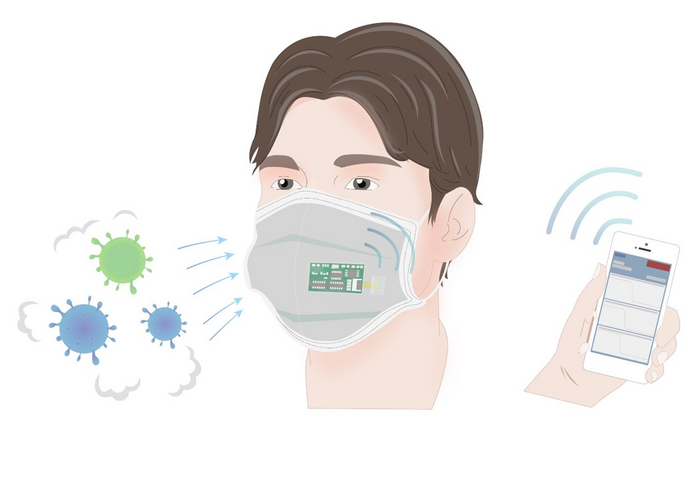Life Sciences
Face Mask Detects Respiratory Viruses, Alerts User
Scientists at Shanghai Tongji University in China have created a face mask that can alert the wearer to the presence of respiratory viruses in the surrounding…


Scientists at Shanghai Tongji University in China have created a face mask that can alert the wearer to the presence of respiratory viruses in the surrounding environment, including the viruses behind COVID-19 and influenza. The mask includes aptamers, which are short sequences of DNA or RNA that can bind to protein targets. When viral particles bind to the aptamers, ion-gated transistors boost the signal so that the mask can sensitively detect small amounts of virus. The mask sends a message to the wearer’s smartphone within 10 minutes of detecting the virus. The technology could be very valuable for healthcare staff or vulnerable patients who are at high risk of severe disease.
Face masks have been a cornerstone in our response to the COVID-19 pandemic. The simple and effective barrier function such masks fulfill has doubtless helped to limit the spread of SARS‑CoV‑2. However, what if our masks could do much more, providing us with an early warning system that viral contamination is in the air?
“Previous research has shown face mask wearing can reduce the risk of spreading and contracting the disease,” said Yin Fang, a researcher involved in the study. “So, we wanted to create a mask that can detect the presence of virus in the air and alert the wearer.”
The team behind this latest study has created just that. Their mask does not just detect SARS‑CoV‑2, but it can also identify two different strains of influenza (H5N1, and H1N1). With the southern hemisphere experiencing a significant resurgence of flu this year, after two years without much flu activity, such technologies could be helpful for vulnerable patients who could experience serious complications if they were to contract flu or COVID-19.
The mask relies on aptamers, which are synthetic molecules made using DNA or RNA, but which function somewhat like antibodies, binding specific molecules such as proteins. The aptamers in the mask are specific for SARS‑CoV‑2, H5N1, and H1N1. If such viral particles are present in the air around the mask wearer, they will bind to the aptamers in the mask. Ion-gated transistors present in the mask sensor then help to boost this signal, allowing the mask to take highly sensitive measurements.
The mask will then send a signal to the wearer’s smartphone within 10 minutes to alert them to the presence of viral particles. The researchers are working on reducing this time, to help make the system as quick and useful as possible.
Study in journal Matter: Wearable bioelectronic masks for wireless detection of respiratory infectious diseases by gaseous media
Via: Cell Press

Wittiest stocks:: Avalo Therapeutics Inc (NASDAQ:AVTX 0.00%), Nokia Corp ADR (NYSE:NOK 0.90%)
There are two main reasons why moving averages are useful in forex trading: moving averages help traders define trend recognize changes in trend. Now well…
Spellbinding stocks: LumiraDx Limited (NASDAQ:LMDX 4.62%), Transocean Ltd (NYSE:RIG -2.67%)
There are two main reasons why moving averages are useful in forex trading: moving averages help traders define trend recognize changes in trend. Now well…
Asian Fund for Cancer Research announces Degron Therapeutics as the 2023 BRACE Award Venture Competition Winner
The Asian Fund for Cancer Research (AFCR) is pleased to announce that Degron Therapeutics was selected as the winner of the 2023 BRACE Award Venture Competition….














